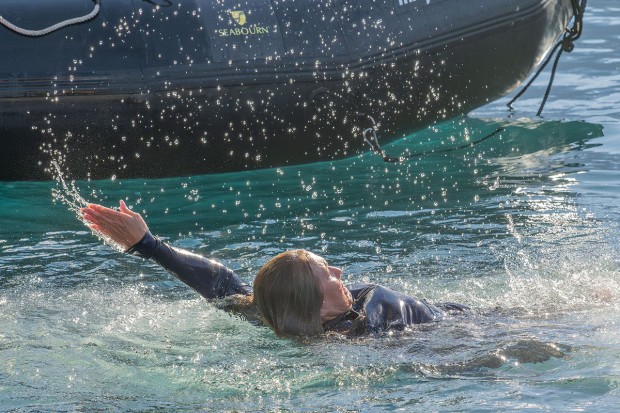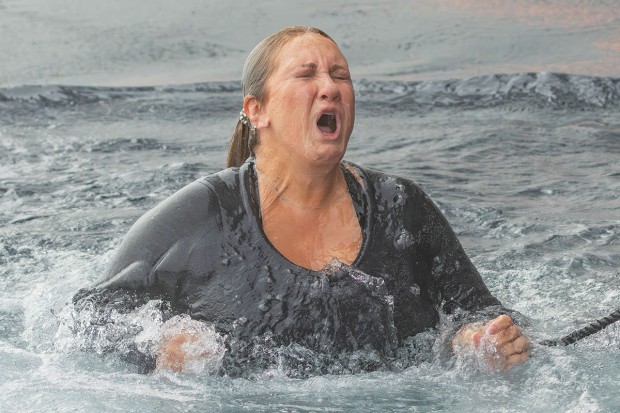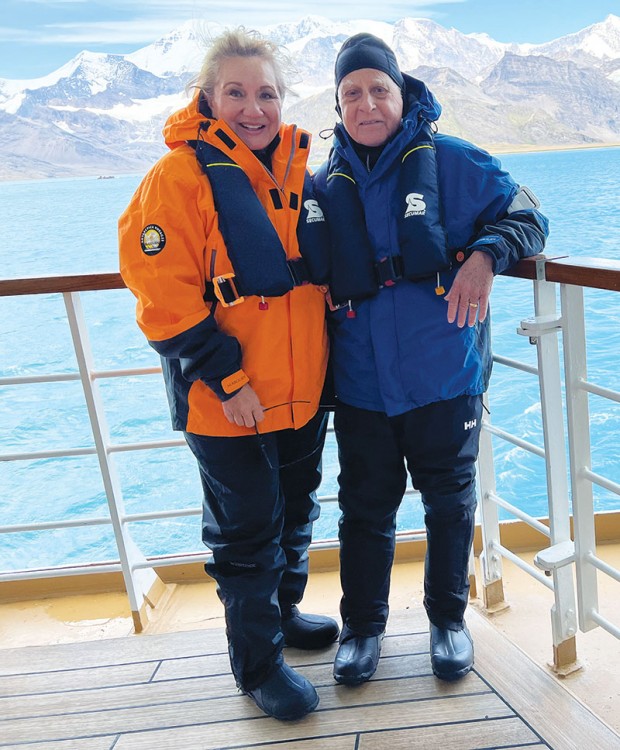From Wartime Nicaragua to the Polar Plunge

Dr. Joseph and Terry Agris began their travels together nearly 30 years ago, beginning with one of their most intrepid forays ever: a medical mission to Nicaragua during the country’s civil war. Dr. Joe, as his friends call him, is a plastic and reconstructive surgeon who has done more than 10,000 surgeries outside the borders of the US over the years, earning a Presidential Medal of Freedom in 2010 for his service, and wartime Nicaragua was not unusual for him. For Terry, an insurance company executive, it was a trip that changed her life, that opened her eyes to the vulnerability of the human condition.
That would be the first of many journeys together. “Our travels have always been twofold,” said Terry. Some were for the missions, including Peru and Bolivia, Egypt and Syria, Jordan and Turkey; others were just for fun, like Joe’s fishing trips in Alaska and Nicaragua, and Terry’s hunting expedition in Macedonia. As adventurous as the pair are, they also like their luxury, so their first cruise together was aboard the massive 2,400-passenger Queen Mary.
“The Queen was like the Titanic, if you saw the movie. You wear a tux for dinner, you know?” The good doctor, clearly a Brooklyn boy, still carries his native accent with him, decades after having left the city.
The cruise began a tradition for the couple, who returned to the Queen Mary over the years for their high-side life. They were aboard the ship during the 2004 Olympics, docked off the shore of Greece, where she served as a floating hotel for attendees of the games. Most memorably, they were aboard the craft on April 29, 2011, when Prince William of Wales married Kate Middleton, and the wedding was broadcast live for the passengers, while the menu was identical to that of the wedding itself. Then they landed in the London port, where the entire country was still celebrating.
And so it went, with their journeys exploring the extremes; some missions, like Pakistan and Guatemala, Dr. Joe went and volunteered solo, as Terry had to work. And Terry took some solo trips, too, like girlfriend getaways in Europe.
Covid-19 put the brakes on the medical missions, however, and these days, since their retirement, their adventures are more likely to be excursions from the comfort of a cruise liner.
The seasoned surgeon hasn’t ruled out other missions in the future. At 82, he’s still passionate about the work, and about travel itself; he remains a major globetrotter. But nowadays he’s ready for his journeys to be a little less taxing.
“Until Joe retired, we would fly to places and spend a week or two weeks and then we would come back home,” said Terry. “But once we retired, we started doing cruises because it was just so easy. We would just fly somewhere, get on a boat, and not have to do anything. So it was much more relaxing.”
Some of their shore excursions are anything but relaxing, however – and these cruises are not your average garden variety, Joe hastens to add. “We're not talking about people who take seven- and eight-day cruises. We're talking about a month and a half or two months at a time. Our shortest cruise last year was 32 days.”

TAKING THE PLUNGE In the course of the past year, Terry Agris completed three “Polar Plunges”: docked off the coast of Greenland, Terry takes a swan dive. (Photo: Daniel Fox, courtesy of Seabourn)
In the past year alone, he and Terry have logged more than four months at sea on four cruises: one to the North Pole, one to the South Pole, and two transatlantic cruises to Europe. Their longest cruise together was earlier this year – Miami to South America and Antarctica, for a total of 46 days.
The Arctic Circle cruise was especially exciting. That’s when the couple signed up to board a submarine to go down and observe the ocean floor – and it’s when Terry decided to do something that Joe believes should land her a place in the record books: She did the Polar Plunge at both the North and South Poles, all within six months.

Doing the backstroke with ease in Greenland’s 32-degree waters. Earlier this year, on a separate cruise, she did a similar plunge in Antarctica, also 32 degrees. (Photo: Daniel Fox, courtesy of Seabourn)
Terry, who was on the swim team in high school, has long had a goal of diving into every major body of water in the world. So when the couple set off on their Seabourn Cruise to the Arctic, she consulted with the expedition team leader, and he assured her that there would be an opportunity for a dive. Joe wasn’t interested in taking the plunge – “How many crazies do you need in a family?” he retorted jokingly. He was, however, her No. 1 cheerleader – and medical advisor – as she geared up for the dive.
The North Pole expedition was a part of the 28-day Svalbard, Greenland and Icelandic Sagas Cruise aboard the Seabourn Venture. They flew to Oslo where they boarded a charter flight to Longyearbyen, a tiny town in the Norwegian archipelago of Svalbard known for its spectacular views of the Northern Lights. From there they set sail for the North Pole, just 650 miles to the north, on a four-day journey called the Svalbard Experience.
Terry was one of 10 to sign up for the Polar Plunge on that cruise, and since she’d dived into freezing waters before, she wasn’t thinking it would be a big deal. Joe, however, wasn’t so sure.
“Life expectancy was only 3 to 4 minutes once she got in the water,” he said. He was reassured by all the safety measures that were being taken – there were cardiac monitors and adrenaline shots at the ready, and she would be belted in and tethered to the ship, and could be quickly pulled out should anything go awry.
When the time came, she stepped out onto the diving platform without hesitation and plunged in, feet first. It ended up being a bigger deal than she had anticipated, and she didn’t even realize the full impact until about a week later, when she took another plunge in Greenland, which is three degrees warmer, at 32 degrees (seawater freezes at 29 degrees).

After her plunge at the North Pole, gasping from the impact of the most extreme plunge at 29 degrees Fahrenheit. (Photo: Daniel Fox, courtesy of Seabourn)
“Terry did a beautiful swan dive off the boat, and she swam out and then she backstroked back,” said Joe proudly. “She did such a good job. The videographer there showed it on the boat that night.”
At the South Pole, the water was also 32 degrees, Terry said, and she did the same thing there.
“I'll tell you one thing,” said Terry. “There is a big difference between jumping into 32-degree water and 29-degree water, which is the temperature at the North Pole. There it feels so different – it was like needles were coming into you immediately as you hit the water. That was the oddest experience.”
She may have looked unfazed as she swam back to safety, but she quickly clambered out, grabbed her robe, went straight to their room, and jumped into a hot shower.
“My skin immediately turned crimson red,” she said. “Now, when I jumped in at Greenland and the South Pole, I just got out of the water, I put my robe on, I went over, got a drink, and went out and watched everybody else jump in the water. It was just so different.”
Another major highlight on the North Pole cruise was when they boarded the Seabourn luxury submarine, descending to the ocean floor to observe an otherworldly landscape of drifting jellyfish, colorful starfish, and sea anemones larger than people.
This summer, the couple was taken aback when a tourist submersible on an excursion to the shipwrecked Titanic made headlines when it went missing and then imploded. “That sad situation kind of hit me in the face,” Terry said.
Nevertheless, they treasure the experience. Wildlife was a major draw on the North Pole cruise, and the Antarctic one as well: orcas and dolphins, whales and seals. The biggest difference, besides the temperature, was that in the North they saw polar bears, while in the South, they saw penguins – lots and lots of penguins.
“We saw penguins out the wazoo at the South Pole,” recalled Terry. On the island of South Georgia, after leaving Antarctica, they stopped and took a shore excursion that they’ll never forget. “We were at a landing where we saw over 200,000 penguins. And you can't even describe it. It was just penguins – just a sheet of penguins, everywhere.”
There were king penguins and rockhopper penguins, Magellanic penguins and chinstrap penguins. And they were not afraid. Just like in the Galapagos, another one of their all-time favorite cruises, the animals have no predators on land, and so they know no fear when it comes to their human visitors, walking right up to them whenever they have the chance.

Doing the backstroke with ease in Greenland’s 32-degree waters. Earlier this year, on a separate cruise, she did a similar plunge in Antarctica, also 32 degrees. (Photo: Daniel Fox, courtesy of Seabourn)
The memories from their polar cruises will stay with them for the rest of their lives: clambering aboard the rubber inflatable zodiacs to float among the towering glaciers; hearing the thunderous explosion of a calving glacier; watching a polar bear covered in blood as it dined on a seal it had just hunted, and then, warm and safe back on their floating hotel, enjoying a fine meal. Navigating the extremes, from the cold of the two poles to the heat of the tropics, as they made their way from winter to summer, from Miami to Panama and through the famous canal, and all the way down the coast of South America.
But the biggest highlight for both of them on the cruises, as with all their travels, says Terry, is always the people. She’s always surprised by the similarities, regardless of the difference in life circumstances; and also the differences, “what makes each person special.”
Joe also finds the offline environs of a transatlantic cruise to be the perfect place to unplug and write novels inspired by his mission trips.
Standouts include the three-novel “Dr. Angel” series, named for a moniker he earned during his work in Pakistan, where he fell in love with the people and returned again and again (Tears on the Sand, Miracles in Bedlam, and Mission Divided). He also wrote White Knight in Blue Shades, a biography of Houston journalist and TV personality Marvin Zindler, who accompanied him on many of those missions.
For Joe, his travels have been a humbling experience; the eye-opening experiences he’s encountered on his mission trips, as well as the scientists’ presentations, for example, the geologists’ talks on the scope of geological time, have given him a broader perspective on the world. He remains in awe of the resilience of the Pakistani people, who he calls the toughest he’s ever met. “You know, it gets to 120 degrees, and they're living in a mud hut, and it gets below zero, and they’re in the same mud hut. They have no electricity, and no refrigeration, so they have to go to the market each day. People might have two changes of clothing… then you think about the United States, where people have closets filled with clothing.
“It lets you see that there’s so much more out there than the little world you live in,” he reflected. “You know, you may see it on TV or read the book, but when you're actually there, it kind of makes you feel like you're a little ant in an anthill in your own little city back home, compared to what else is out there.”
Editor's note: See this story at thebuzzmagazines.com to watch Terry plunging into freezing waters.
Want more buzz like this? Sign up for our Morning Buzz emails.
To leave a comment, please log in or create an account with The Buzz Magazines, Disqus, Facebook, or Twitter. Or you may post as a guest.



